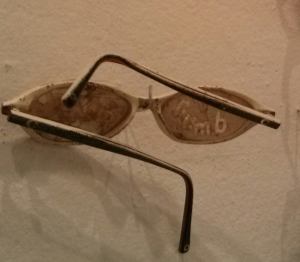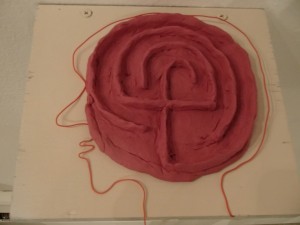Webinar: 10/29/2014 with Bessel van der Kolk speaking Ruth M. Buczynski at http://www.nicabm.com. If you’re a frugal or broke trauma survivor interested in this information – for free – here are my notes. If you want the video or transcript it can be purchased at the NICABM website. These are not minutes. I’ve captured about 75% of what was covered. I wrote as fast as I could!
van der Kolk on Trauma in 2014
 Terror & Blunting
Terror & Blunting
“Your experiences of self gets blunted” and that blunting happens in the body, you have heart ache or gut wrenching feelings van der Kolk explained. “Your body feels bad.” To deal with those bad feelings, some take drugs and some seek other ways to get an internal distance.
What else gets blunted, said van der Kolk:
- pleasure
- sensitivity
- excitement
- connection
(you know – the good stuff)
My note: When you have a leak in one pipe – sometimes you have to shut the water down entirely to stop that one sink from overflowing. It can be done. But with the water off – it’s going to be hard to shower.
Rorschach Test
Van der Kolk said, “You show ink blot to people like you (Ruth)/me – We see a motorcycle. Show to traumatized people they see a torn vagina, kid killed.” There’s “a real loss of innocence” he said, and “always perception ‘ is this the trauma again?’ and seeing it everywhere.
Another thing he noted is that for 1 in 4 people, they saw nothing (I’m pretty sure he didn’t say all people but 1 in 4 trauma survivors). That to him was quite disturbing.
Humans live through imagination, he said, and project. For example, he said, he could anticipate and imagine the webinar before doing it. For people with trauma it’s hard to organize stuff, life and people around safety if you can’t imagine safety. “Imagination is a form of planning” before execution of plan he said. In order to “go somewhere” “one needs to imagine where to go.” He said, like getting mother a gift, picturing what she will like, what will make her happy, and how all of that is related to making and executing plan and action.
My note: This is why I think people Belleruth Naparstek – HealthJourneys.com – who wrote Invisible Heroes have success with guided imagery to treat post-traumatic stress. She understands the importance of this and how guided imagery beautifully supports trauma survivors, relieves symptoms, can be done alone, at will and doesn’t require therapy to be effective.
Feminists and other change-the-world activists also know this.
“One thing is clear,” wrote Gloria Steinam in Revolution from Within, “The human mind can imagine both how to break self-esteem and how to nurture it – and imagining anything is the first step toward creating it. Believing in a true self is what allows a true self to be born.”
Flashbacks
Van der Kolk talked about how flashbacks are not “the most problematic issue” in Post-traumatic stress but that they are important. For those with trauma he says it’s more than just images connecting people to a particular memory. For adults traumatized as kids or traumatized kids, “they behave as if they are back there” and it’s not conscious or a choice. He gave the example of someone reacting like a frightened person if boyfriend is angry but it’s not that the mind is feeling connection to the memory of childhood but the feeling of being frightened goes there.
My note: As someone with PTS, it’s not that my mind goes back there, it’s that’s “back there” is not “back there” but right here. It’s not that I, in present, go into the past as though it’s a room I want to visit or enter. It’s that, uninvited the feelings of the past are like an aroma that seep into the present, but this happens on a feeling level. For example, when a skunk sprays and you smell that, you aren’t thinking of how fresh and clean the air was prior to the skunk smell you are just overpowered with that odor and can almost taste it even though you’d much prefer to smell peppermint or coconut. The problem is that the past doesn’t get filed well in the past or know how to “stay.”
Offline Brain & Broca’s Area
When someone is reliving trauma much of the brain goes offline and bodies, Van der Kolk says, “behaves as if stress is now.” He said the ‘time keeping’ part of brain that knows ‘that was then and this is now’ goes offline. So, it in fact does feel like it’s happening now when trauma is being relived (as opposed to remembered).
“People become dumbfounded when they go into trauma” he said and “you can’t really talk. Speech center (broca’s area) goes offline.”
Van der Kolk admitted that this realization has been slow to reach therapists and clinicians who treat people with trauma. Language, though important, has limited capacity to access trauma. “You become speechless” he said.
My note: I want a refund for all the talk therapy, for all the “feel it to heal it and often get re-traumatized’ days of therapy when the experts (the same experts BTW) thought talk therapy or medication was all that. Can I get my money and time back? Recall. Recall.
Smoke/Detector/Cook/Watch Tower
Smoke detector is primitive part of brain “that makes you be afraid.” This is where the amygdala comes in and the part of the brain that gets “hyperactive” when similar to trauma stuff happens. He mentioned how no one has really “nailed it” when it comes to figuring out how to rewire the brain.
Cook – I didn’t catch what this was – something to do with part of the brain that puts images, sensations, sounds and mixes and integrates the “ingredients” all together.
Watch Tower: Part of brain that calms the thalamus (maybe with neurofeedback, EMDR “probably” – the part of brain that helps one be less reactive.
My note: The Body Keeps Score put out by Viking this year covers most of this stuff if you want more detail. I paid for the book and it’s an in-depth history of trauma treatment as well as informative about current trauma treatments. Be warned though if you are a trauma survivor that it’s a medical model and you. when addressed or referred to, are done as as a “patient” (as opposed to a person). This isn’t always off-putting (it was also true in Sebern Fisher’s work and it didn’t bug me. It bugs me here because the author also does things such as compare a veteran he was treating to his toddler. So, when I say it’s infantlicizing – it’s almost literal. Though there are other parts tender and caring, sometimes it misses so badly it’s actually hard to read and since I know this man probably has more influence than any other on how trauma treatment defined, understood and studied it’s worrisome. I’ve followed his work the way some follow bands and will continue to do so but the Trauma Center needs to collaborate with trauma survivors in a professional setting and not only get informed by the trauma survivors in crisis who need services.
Good News/Bad News
He said, “good news” is that this part of the brain (Watch Tower) follows the laws of neuroplasticity and the more it’s used the better and stronger it becomes. The bad news is that no one knows how or has proved how to rewire amygdala.
My note: Consider doing free-writing, doing yoga, eating well and practicing guided imagery or some form of mindfulness before talk therapy or medication. I’ve used all of these but medications have side effects and can be grueling to get off of and talk therapy makes some feel worse, requires an appointment and is often expensive. Do what appeals to you most and find what works. Remember, you are the expert on what works best for you no matter what anyone says. Those of us in the trenches can keep communicating via social media and tell each other what works and assist ourselves and one another.
Vagus Nerve
Charles Darwin wrote about it in 1872 as the “nerve connects brain to body” and how heart wrenching and gut wrenching and that bio-directional nerves have recipricol relationships body to brain and brain tbody. If you can calm body you can calm brain.
My note: We’ve not come that far. Stephen Porges is also talking about calming the brain through calming the body and expanding these types of thoughts with Polyvagal Theory.
Job of Therapist
“not to find solutions for our patients” van der Kolk said, instead, it is to “keep people quiet and still enough” and focus on “being very present in heare and now.” For him, he used breathing, tapping acupressure points, eye contact and is an “affect regulator” so clients can “visit past without getting hijacked”
In past, he said, he and other therapists would hear terrible stories and delivered by “flat tone of voice” because person with rauma, trlling it, was elsewhere. He said the therapist gets’ upset or joins the person is being numb.
My note: Again with wanting a recall or refund on trauma therapy old school style. And, if you can quiet and be present, you know, for free – that works too 🙂 Seriously, $100. an hour, maybe fighting traffic both ways, you know, to practice stillness. There’s also going to a park or a yoga studio as an option.
 Need for Silence and to Experience the Self
Need for Silence and to Experience the Self
People who have been traumatized don’t want to experience self and need help, he said, to tolerate sensations.
“20 years ago” van der Kolk said, we “only used words to say look at how screwed you are” but couldn’t change organic responses to trauma. The western psych traditions didn’t include a lot of silence or the introceptive approaches of the East. Only now are other traditions “slowly coming int our world” and ways of activtating the Watch twoer part of brain being examined and used (mindfulness, neurofeedback, maybe EMDR, etc.).
The Original Affect Regulators and Trauma Experts Find Attachment Theory
Parents are the affect regulators who help train a child’s nervous system said van der Kolk. It’s actually disorganized attachment that is showing to be the cause of dissociation.
If parent is not a source of physiological comofort, doesn’t:
- look at
- pick up
- respond to distress or overpowers your response (gets more upset than you about how upset you are)

a person doesn’t learn how to regulate a self. That regulation of self starts in relationships with others. Without those responses, a person doesn’t have a conditioned response (the expectation) that things will be o.k., or will get back to o.k.
And, this is how and why you can have really smart and insightful people who, when triggered, go right back into the “animal brain” he said, and it is as though they are “managing a frightened dog inside.” Saying, “You shouldn’t be scared” does not help (in fact, it makes it much worse I would say). Here’s why:
“Insights doesn’t quiet the limbic system” he said. What does Quiet the Limbic System? The Things We Do With Babies, Mostly
- Touching
- Feeding
- Rocking
- Holding
- Trying Things, Gradually
- Exploring/Succeedding with someone who pick up after a fall
- Engagement in Activities that Make One Feel Safe (he mentioned things taught or known by Japanese collagues: sword fighting, drumming, for ex.)
Plus neurofeedback.
Nuerofeedback
Neurofeedback also quiets the nervous system to “harvest brain waves to change own brain waves.” He said it has “strikingly good results” for PTSD and addiction but funding crowded out by pharma. Still, there’s “robust drop in arousal” and increase in executive functioning (cited studies done in the late 80’s and early 90’s but I didn’t hear who they were by, if names were said so I can’t link to that research to know for sure if it’s what he was referencing).
My note: van der Kolk admitted that “our knowledge is relatively young” but that it’s the “body people” (Levine and Ogden) who have led the way. For those who have been advocating for body work and working successfully with trauma survivors even before the experts “legitimized” the work – THANK YOU!
 Misc./Webinar
Misc./Webinar
I didn’t cover stuff in beginning on re-traumatization because it was touched on but not fully explored. I didn’t cover Stan & Uti (Udi) who were both in the same car accident, had PTSD but brains different in way impacted.
Photo Credit: Margaret Bellafiore
You Matter Mantras
- Trauma sucks. You don't.
- Write to express not to impress.
- It's not trauma informed if it's not informed by trauma survivors.
- Breathing isn't optional.
You Are Invited Too & To:
- Heal Write Now on Facebook
- Parenting with ACEs at the ACEsConectionNetwork
- The #FacesOfPTSD campaign.
- When I'm not post-traumatically pissed or stressed I try to Twitter, Instagram & Pinterest.
I found the dialogue you started by giving the new Van der Kolk book on the Amazon website a review of only a single star quite illuminating. Your writing so expertly expresses the voice of the PERSON with trauma, the voice that is missing from his book.
I personally did like the Bessel van der Kolk book & did not feel infantilized. I came here to find out whether the nicabm site would be worth the trouble & it sounds like it would not be (because I have already read the book). Thanks.
I would like to add Pesso to ‘what works’ in my experience. It is also in his book. It is body-based group therapy and it basically means that the inner child gets what it would have needed back then. So it can be a pretty targeted way of dealing with issues. And because there is a group (and they each get a role in your structure), you can experience an alternative to what was normal back then.
Like other forms of therapy – or any way of dealing with trauma that actually works, including meditation – it can bring a whole lot of emotion to the foreground.
So – as Bessel rightly says – each one of us has to learn to trust our own instincts as to what we need. And that IS precisely what you say too – so I would say you’re in agreement. It is also putting the responsibility with the person who is experiencing the trauma, which is hardly talking down on us.
However, I can imagine that something in the tone of the book might not appeal.
Hi Katinka:
Thank you so much for your comment. I love hearing different views and experiences and appreciate it. I really admire his work, in general, and know many others love the book and exactly as is. It’s hard to know how much I projected on the tone from having been to the trauma conference in 2014.
Thanks again. I’m glad there are more and more options available and thanks for sharing about Pesso.
Cissy
Why is hypnosis not mentioned as a way of evoking positive neutrality and higher awareness… why skirt it with guided imagery… too much competition with “traditional therapy?”